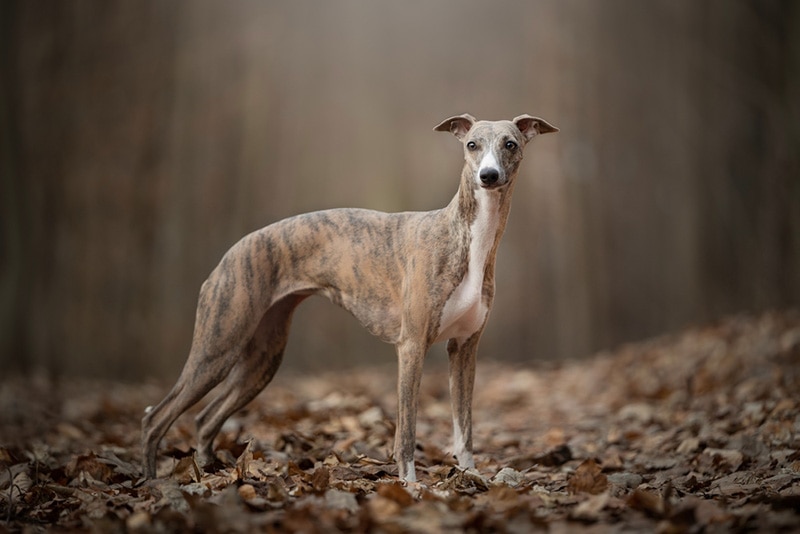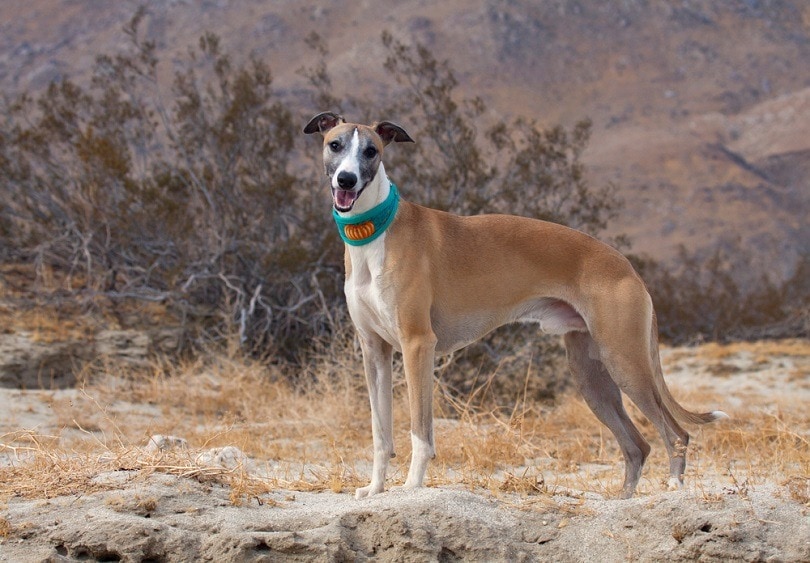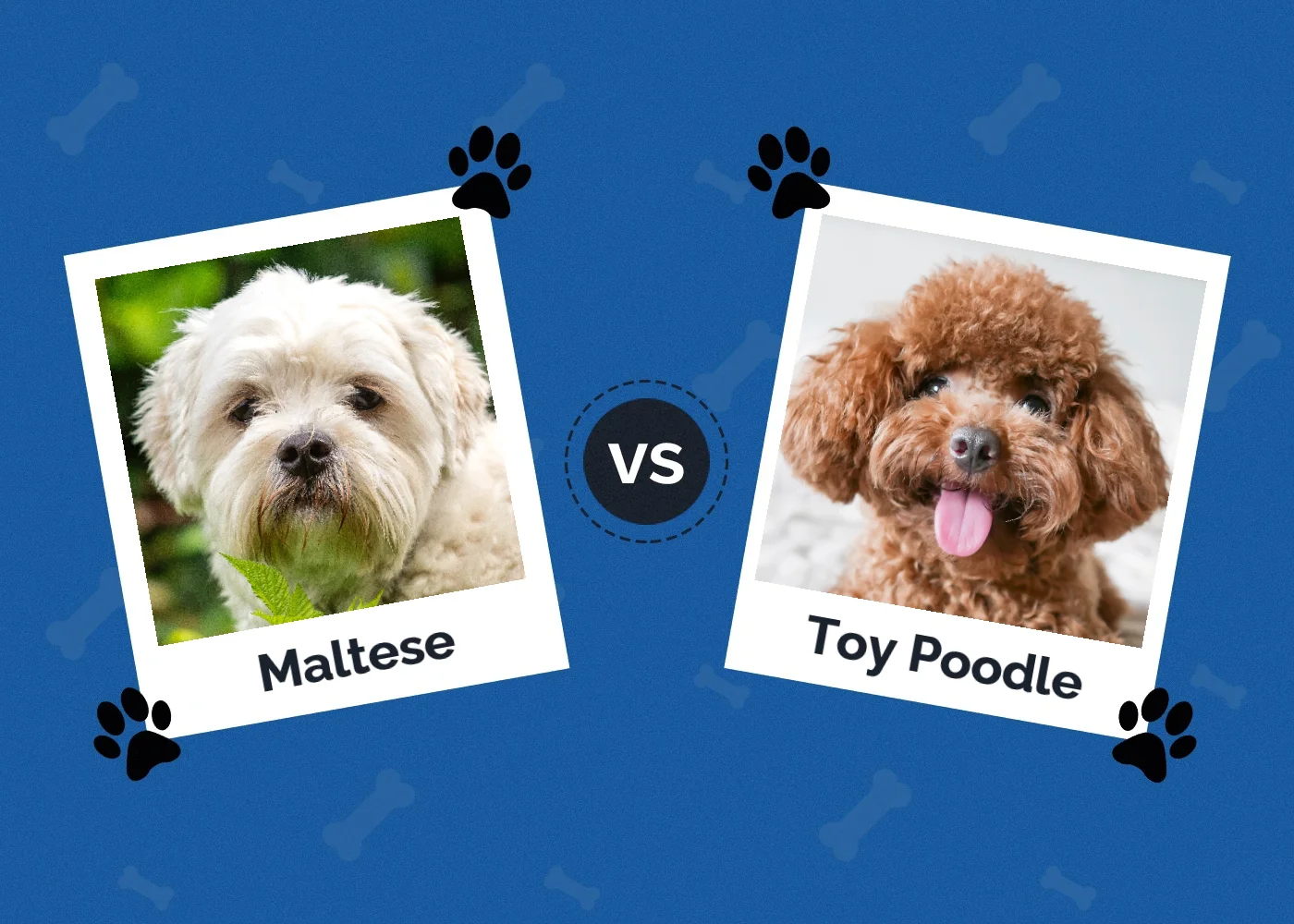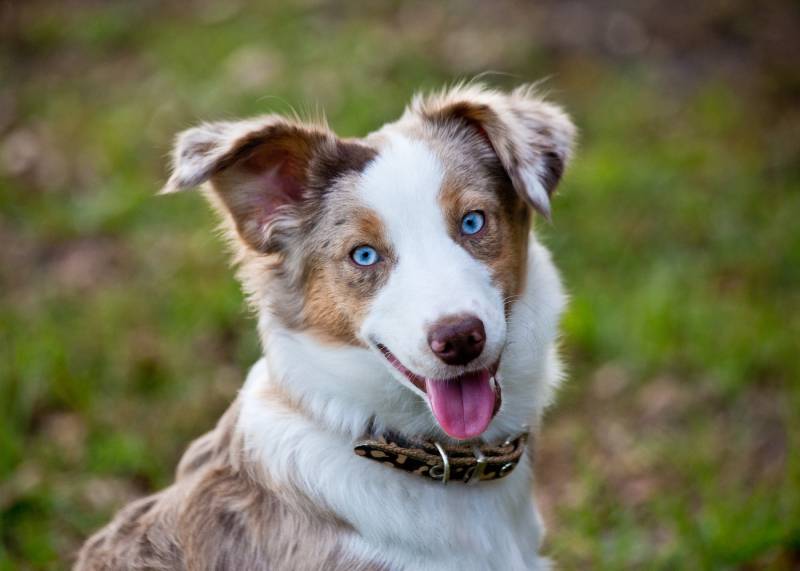How Big Does a Whippet Get? Average Weight & Growth Chart

Updated on

Click to Skip Ahead
With their slender bodies, Whippets don’t spare an ounce for unnecessary bulk. The athletic sighthounds are lengthy and lightweight, boasting a body uniquely tuned to giving chase and excelling in speed-based competitions.
Fully grown, a Whippet will be around 23 – 33 lbs and 18 – 22 in. One look at the Whippet’s powerful form makes it clear why they’re such a prize. But the strong and nimble build is no guarantee. As you’ll discover, several factors determine how your Whippet will grow, including those you can control and some you can’t. Let’s explore what to expect with this breakdown of how big Whippets get.
Whippet Overview
The Whippet originated in England, where hunters used the speedy dogs to chase rabbits and various small game. Dubbed the “poor man’s racehorse,” the Terrier-Greyhound cross grew in popularity during the 1800s as a racing dog for the working class.
Playful yet relaxed, the Whippet is an exceptional pet. The affectionate pups are excellent with strangers, children, and other dogs. Their short, flat, and low-shedding coats offer minimal frustration for allergy sufferers and those worried about cleanups.

Whippet Size and Growth Chart
Adult Whippets grow to 25–40 pounds. Males reach 19–22 inches at the withers, while females are only slightly shorter at 18–21 inches. Whippets can reach their full size in about 9 months, but it can take up to a year.
| Age | Weight Range | Height Range |
| 3 months | 9 – 12 lbs. | 10 – 12 in. |
| 4 months | 13 – 15 lbs. | 13 – 15 in. |
| 5 months | 15 – 19 lbs. | 16 – 18 in. |
| 6 months | 17 – 22 lbs. | 17 – 20 in. |
| 9 months | 20 – 27 lbs. | 18 – 21 in. |
| 12 months | 23 – 33 lbs. | 18 – 22 in. |
| 15 months | 23 – 33 lbs. | 18 – 22 in. |
When Does a Whippet Stop Growing?
Whippets typically grow to their full size in 9–12 months. It may take a bit longer for them to put on their adult weight. The fastest growth occurs in the puppy months and slows after roughly 6 months. Though already a lean breed, young Whippets often look scrawny as their weight tries to catch up to their height.
Factors Affecting the Size of Whippets
Whippets have limited growth potential, but owners must still appreciate how they can affect their dogs’ development. Ongoing conversations with your vet about appropriate care routines will ensure you do your part to maximize your dog’s health.

Diet
Dogs need age-appropriate food to control their growth during the first year. Puppy food will have more concentrated nutrition to influence characteristics like cognitive development and bone growth. Portioning is critical. Overfeeding can promote accelerated development in puppies, which could lead to joint problems. At the same time, underfeeding may cause stunted progression and various physical deficiencies.
Spaying and Neutering
Early desexing can significantly influence a dog’s growth. Spaying and neutering delay the closing of the growth plates that build leg length, and the earlier you spay or neuter your Whippet, the longer that delay can become.
Without on-time growth plate closure, a Whippet’s legs have more time to lengthen, resulting in a taller dog. They may also be at a higher risk of injury. Many worry that dogs face physical damage if they engage in overly intense exercise before the plates close. Spay and neuter history can be an essential consideration for trainers as they try to establish a practical and safe routine.
Gender
Male and female Whippets aren’t easily distinguishable, but gender can play a minor role in growth differences. Though both genders have the same weight range, males typically grow a bit taller.

Genetics
The MSTN gene that codes for myostatin production can significantly affect a Whippet’s final size. The myostatin protein inhibits the growth of skeletal muscles (movement-based muscles), an essential factor in ensuring dogs don’t become too bulky.
Unique to the Whippet, an MSTN genetic mutation affects dogs in certain lines. It yields a shortened version of myostatin that cannot play its role as effectively in controlling muscle growth, causing them to grow bigger than usual.
Wild types with two copies of an unmutated gene have unaffected myostatin production, resulting in a slender build. But a Whippet receiving a mutated copy from one parent and an unmutated copy from the other, though still relatively thin-framed, will have more defined musculature. Breeders strive for this genetic arrangement, as these are the fastest, most athletic Whippets.
Then, there are Whippets with two copies of the mutated gene, showing the fullest expression of the genetic quirk. “Bully” Whippets are hard to miss. While roughly the same height as the average Whippet, these double-muscled dogs carry significant mass. In some cases, adult Bully Whippets can weigh over 60 pounds! Although they appear powerful, their added heft limits mobility and speed, making them unsuitable for racing.
Ideal Diet for Maintaining a Healthy Weight
Whippets need a stage-specific diet to maintain their growth and well-being through adulthood. Puppies need denser nutrition and more daily meals to keep up with their rapid metabolism and growth needs. As adults, Whippets typically eat 1–2 cups of food split between two daily meals.
With a breed like the Whippet, exercise is a central factor in managing your dog’s diet. Overfeeding without satisfying their need to run and exercise can inspire unwanted weight gain and obesity. Without burning those excess calories, dogs can face physical and behavioral obstacles that often result in a shorter lifespan.

How to Measure Your Whippet
Tracking your Whippet’s monthly growth is an easy way to fine-tune their diet and exercise plan. Weight and height readings will reveal whether your dog is in an appropriate range for their age.
Weight
The most straightforward way to get your Whippet’s weight is to have them stand on a scale. But it won’t be long before this becomes frustrating, as the dog’s size makes them more challenging to get on the scale. You can train your Whippet to jump on the scale through reward training and positive reinforcement, making it a breeze to get their monthly measurements.
Fortunately, Whippets aren’t heavy for their height, even in adulthood. If your dog isn’t comfortable with the scale, you can hold them. Weigh yourself, then weigh yourself while carrying the dog, and subtract to find your Whippet’s accurate weight.
Height
Measure your dog’s height to the withers, which is the raised shoulder blade section behind the neck. The Whippet’s short coat and toned frame make them easy to find. You can take a tape measure to get the height from the floor to the withers, or you can make it easier by laying a level across the shoulders and measuring the gap between it and the floor. As with weight, height measurements are easier to get from an obedient, well-trained dog.
Length
You can get your Whippet’s length in several ways, including from the tip of the nose to the end of the tail or from the nose to the tail’s base. The most common is the back length running from the tail’s base to the area between the shoulders. Alongside the neck and chest size, this measurement helps fit your Whippet for a coat.
Conclusion
Size is everything for a competitive speedster like the Whippet. Although they’re a naturally healthy, athletic breed, owners primarily determine whether they reach their full potential. Monitoring how big your Whippet gets during puppyhood could have long-lasting implications for your dog, which helps you make the proper adjustments to promote a long, happy, and fulfilling life.
Featured Image Credit: nik174, Shutterstock














